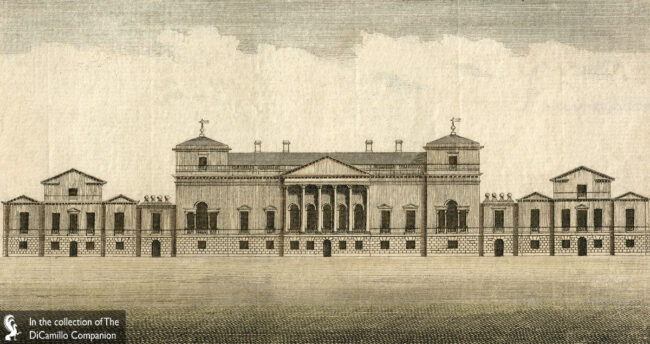
The garden (south) facade from a 1776 engraving that appeared in "A New Display of the Beauties of England"
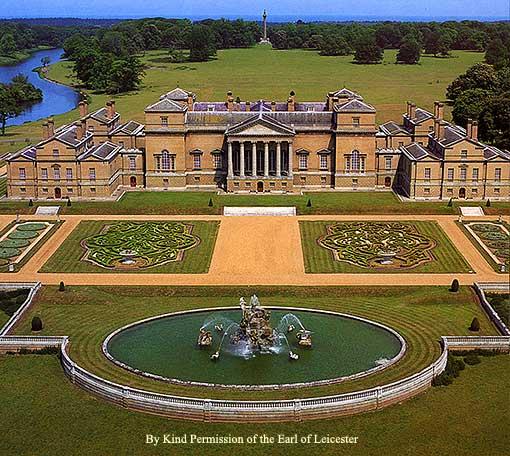
The garden (south) facade from the air
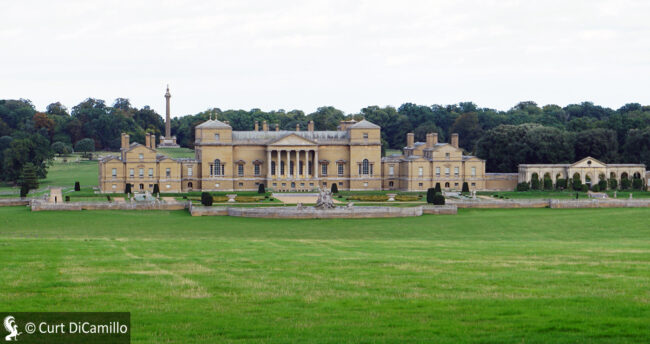
The garden (south) facade
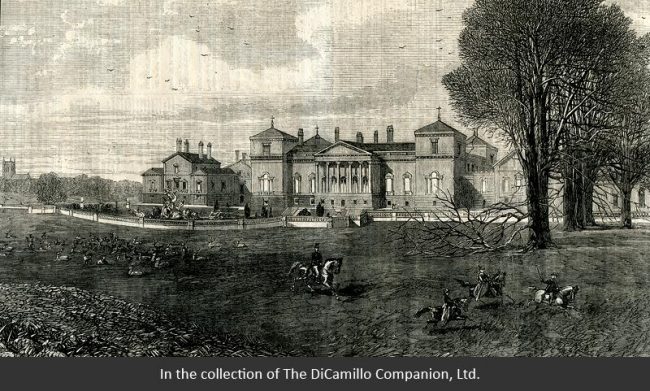
A drawing of the garden (south) facade from the Jan 21, 1865 edition of "The Illustrated London News."
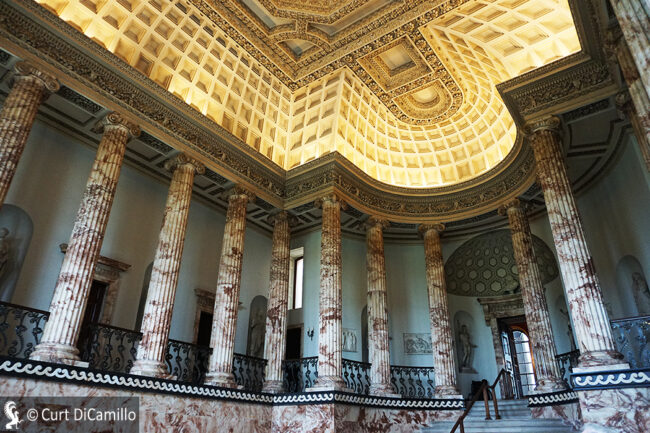
The Marble Hall
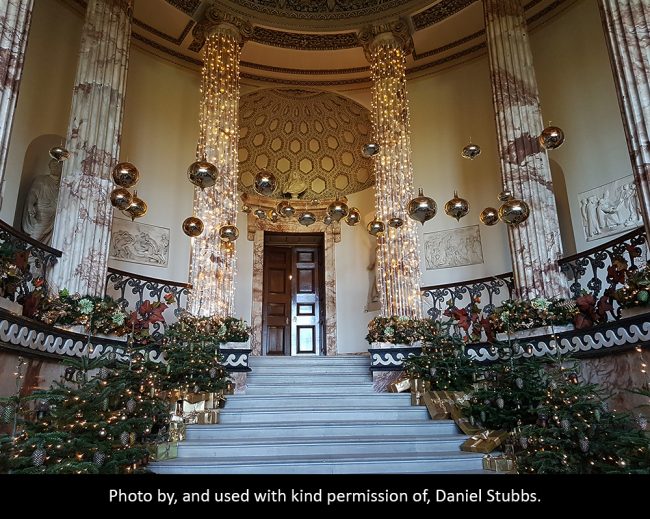
The Marble Hall at Christmas
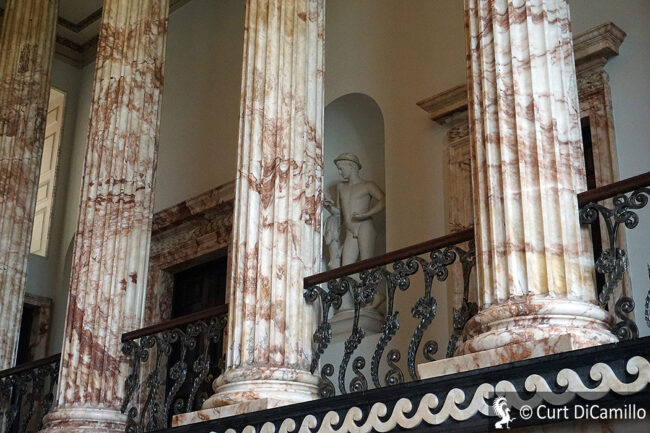
The Marble Hall
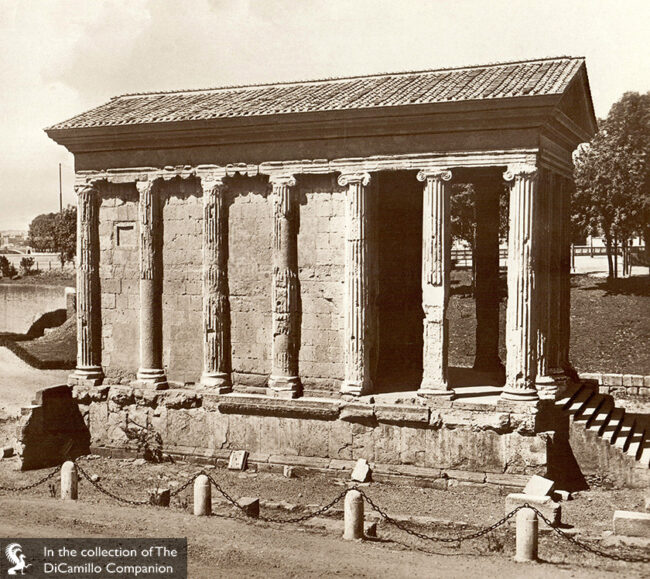
The Temple of Fortuna Virilis, Rome. The 18 pink alabaster Ionic columns in Holkham's marble hall were copied from the 3rd-4th century BC Temple of Fortuna Virilis.
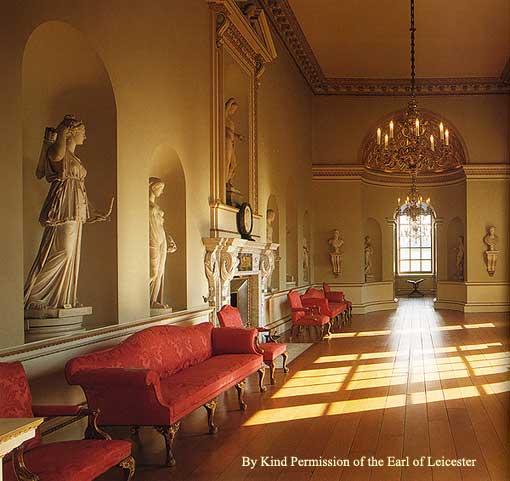
The Statue Gallery
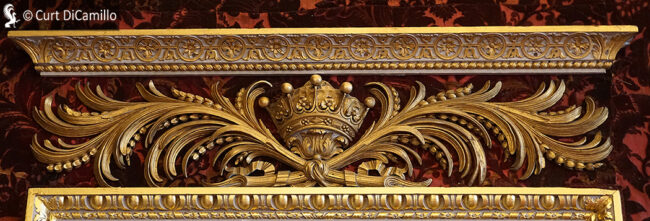
Saloon overdoor
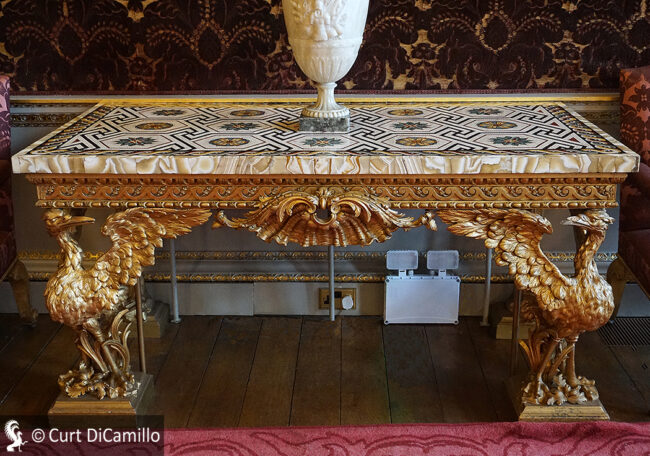
One of a pair of gilded tables designed by William Kent and carved by Rysbrack that incorporate two circa 123-125 AD mosaic pavements excavated from Hadrian's Villa near Tivoli.
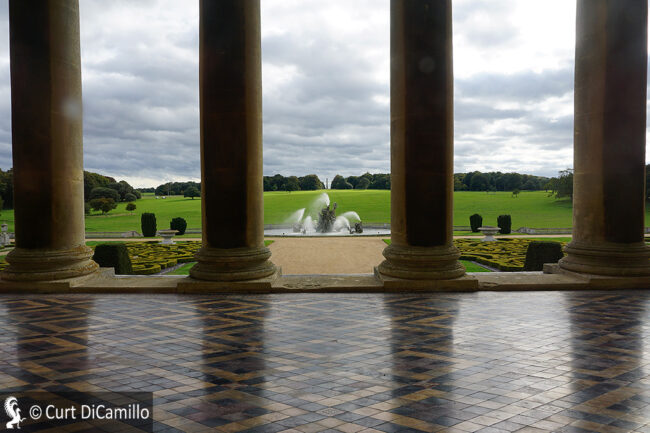
View from the saloon to the south lawn and the obelisk
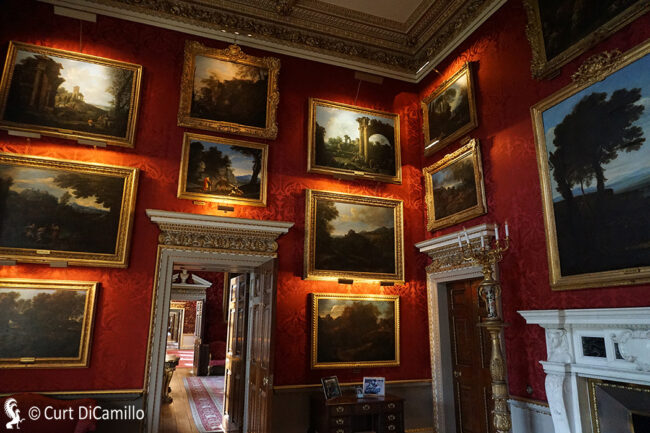
The Landscape Room
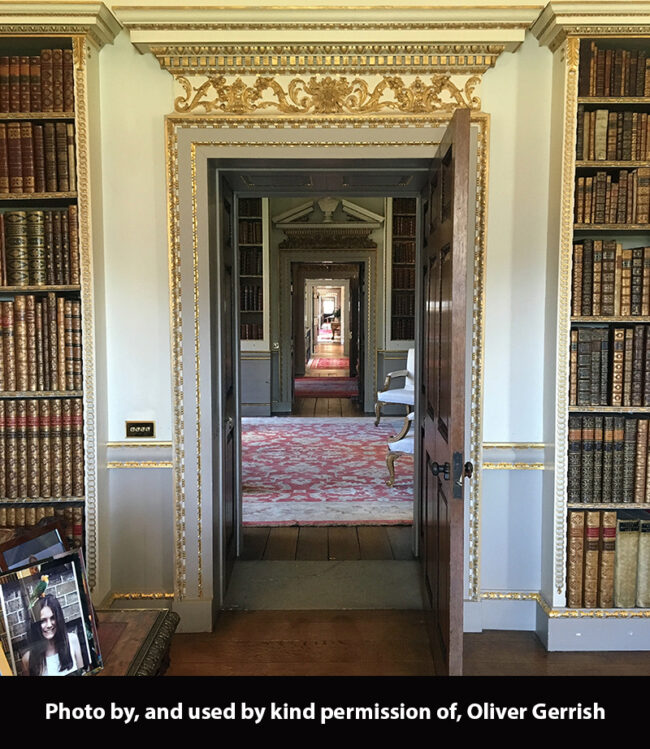
Enfilade
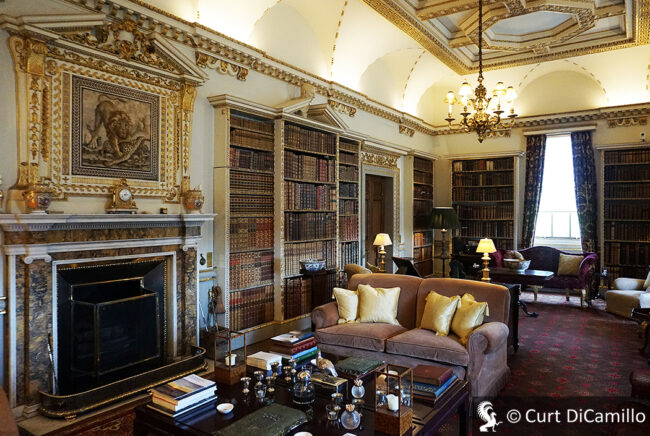
Kent's Long Library
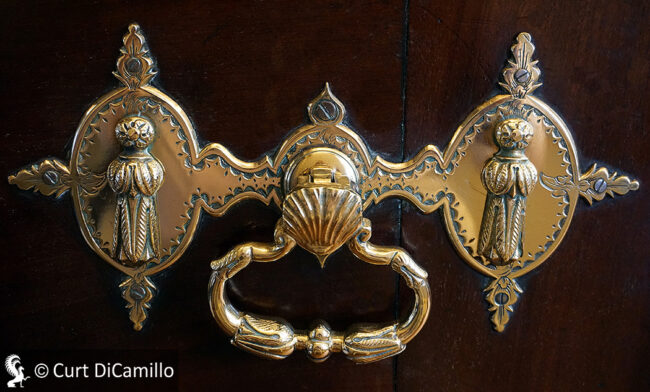
Dining room door hardware
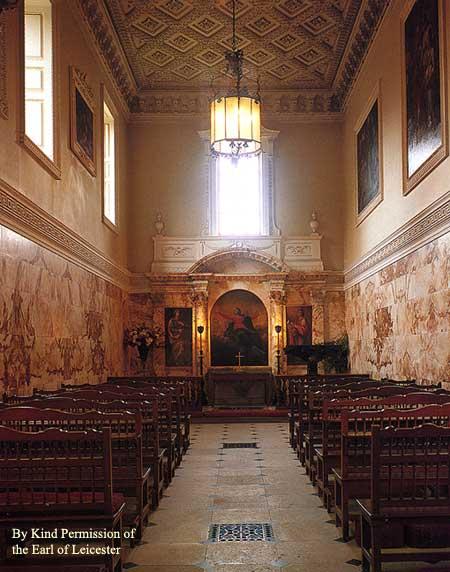
The chapel
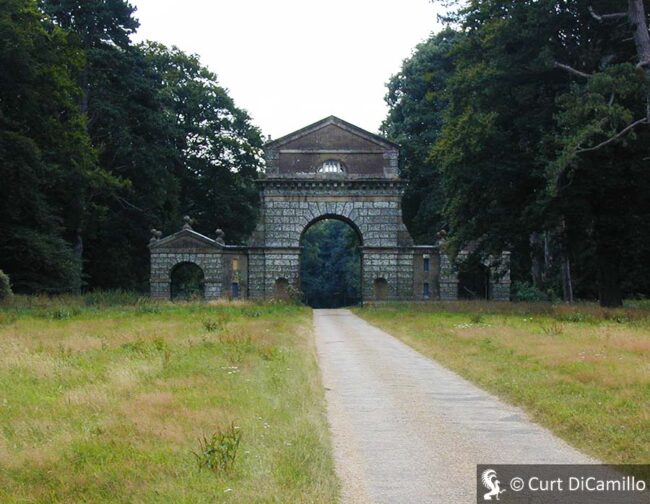
The Triumphal Arch
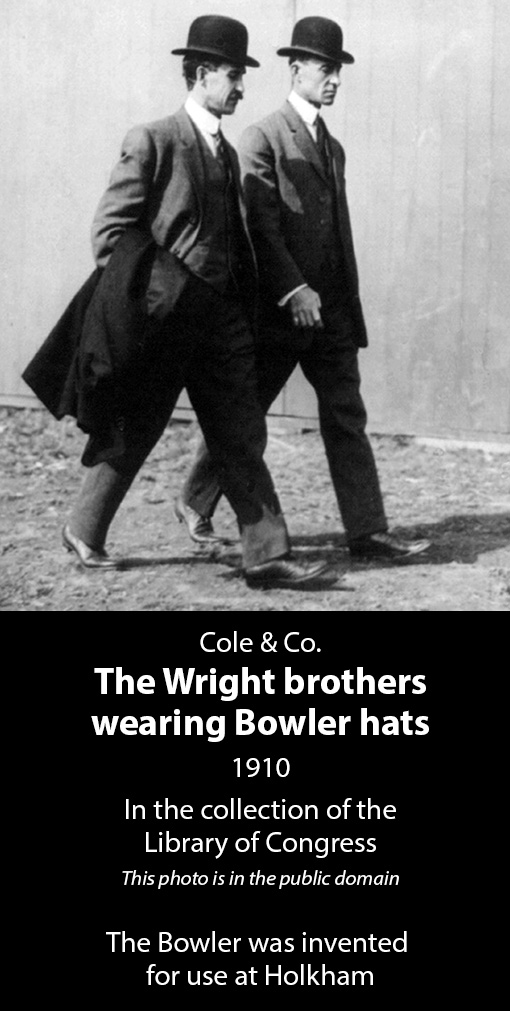
Earlier Houses: Hill Hall, an earlier Medieval house, was demolished by the 1st Lord Leicester to make way for his new house, the current Holkham Hall.
Built / Designed For: Thomas Coke, 1st Earl of Leicester (first creation)
House & Family History: The Coke family fortunes were founded by Sir Edward Coke (1552-1634), attorney general to Elizabeth I and lord chief justice to James I. E.N. Williams, writing in "The Penguin Dictionary of English and European History, 1485-1789," says that "His writings contributed massively to the process of molding the traditional Common Law..." and that he was a judge "...whose knowledge of the law was without equal..." Sir Edward is best remembered for his dictum "an Englishman's home is his castle." Generations later his descendant, Thomas Coke (1697-1759; created 1st Earl of Leicester of the first creation in 1744) returned from his six-year Grand Tour and decided that his Medieval home, Hill House, was not appropriately impressive enough (or large enough) to house his newly-collected treasures (he returned with pictures, books, drawings, manuscripts, and sculpture). Instead, he wanted a grand temple of the arts. The design for Holkham was based on Palladio's unbuilt Villa Mocenigo, as illustrated in his "Quattro Libri." Construction began in 1734, with the yellow-gray bricks all being made on the estate, and was completed by his widow in 1764, ultimately costing the immense sum of £92,000 (approximately £167 million in 2016 values using the labour value commodity index). Holkham was designed, in collaboration with Lord Burlington and Lord Leicester (it's believed that the basic design was Leicester's) by William Kent, between 1734 and 1762. Kent was directly responsible only for the exterior, the marble hall, the statue gallery, the family wing (southwest wing), the long library, and the interior of the family wing. The impressive south facade is 11 bays and is topped with corner towers with low pyramidal roofs; the facade's great portico contains 10 giant Corinthian columns, six of which are to the front. The central block was designed for display and was intended primarily for state functions; it's flanked by four tripartite angle pavilions, each of a single story over a rusticated basement; these were for everyday living and comprise the strangers wing, the kitchen wing, the family wing, and the chapel wing. Each wing is linked to the central block by a single-bay piano nobile. The inspiration for the marble hall was Palladio—modeled on his designs for a temple of justice; the ground level contains walls of pink Staffordshire alabaster with a Greek key pattern below and a wave pattern above. The 18 magnificent fluted pink alabaster Ionic columns on the piano nobile were copied from the 3rd-4th century BC Temple of Fortuna Virilis in Rome (see "Images" section), the coving was modeled after the Roman Pantheon, and the design of the ceiling came from an idea by Inigo Jones. Kent based his design for the statue gallery on the famous ruins of the Temple of Venus and Rome in Rome, a design element that was also used in the gallery at Chiswick House and at Spencer House. The north dining room is a perfect 27-foot cube with an Axminster carpet that reflects the pattern of the ceiling; the bust of Aelius Verus in a wall niche was found during the dredging of the port of Nettuno. The saloon, which contains a fine collection of paintings, has a ceiling to the designs of Desgodetz and contains a pair of gilded tables designed by William Kent and carved by Rysbrack that incorporate two magnificent mosaic pavements excavated from the Villa Adriana (Hadrian's Villa) near Tivoli, which date to 123-125 AD (see "Images" section). The long library, designed by Kent (see "Images" section), contains an exceptionally fine chimneypiece also by Kent (executed by Marsden) of two Ionic pilasters with an overmantel that holds a 1st century AD mosaic of a lion killing a leopard that originally came from the Roman theater in Gubbio; the mosaic, which once was in the collection of the Palazzo Gabrielli-Mignanelli in Rome, was purchased by Coke of Norfolk in the 1770s while on his Grand Tour. Both George V (in 1912) and Queen Victoria (in 1835) stayed in the green state bedroom. Coke of Norfolk (Thomas William Coke, created 1st Earl of Leicester of the second creation by Queen Victoria in 1837), who inherited Holkham in 1776, was a great agricultural reformer (he invented the four-course rotation, involving successive rotations of wheat, grass, barley, and turnips and planted over one million trees on the Holkham Estate). He was also a fervent supporter of the American rebels during the American Revolutionary War. He believed they espoused noble principles of justice and tolerance and is quoted as having said “every night during the American War did I drink the health of General Washington as the greatest man on earth.” William (Billy) Coke, the nephew of Coke of Norfolk, goes down in history as the creator of the bowler hat. In 1850, during a visit to his London hat makers, Locks of St. James's (still in business today—Lock & Co. Hatters, 6 St. James's Street, London SW1), Billy Coke asked Locks to design a hard, domed, close-fitting hat for gamekeepers on the Holkham Estate, one that would withstand the sticks of poachers when the keepers were out on night patrol, as well as provide protection from overhanging branches, and be close-fitting enough that it would not easily blow or fall off. The result was the bowler—so-called because Locks subcontracted the making of the hat to the firm of Bowler Brothers, hat makers in Southwark. The hat was later adopted by men working in the City of London and became known as the "bowler." The bowler also acquired the nickname of a billycock, after Billy Coke, and if one visits Locks today and asks for a billycock they will know exactly what sort of hat you are referring to. A well-made bowler should withstand the weight of a man standing on it (hardened by the application of shellac), but not jumping on it, as Billy Coke did when it was first presented to him! Holkham's gamekeepers still wear bowlers to this day. In America the hat became known as the "derby," from its association with the famous horse race. In the 2021 book, "A Haunting at Holkham," the author, Anne Glenconner, makes the grand house the real star of her mystery novel. A daughter of the 5th Earl of Leicester, Lady Glenconner, who grew up at Holkham, weaves real life and fiction in her bestselling novel about a house she clearly loves.
Collections: Writing in 1985, Francis Russell said that 1st Earl of Leiceser (of the first creation), who formed the collection at Holkham, had a "...precocious taste for collecting in many spheres..." and that he made acquisitions that "...were altogether exceptional..." The statue gallery and tribunes are, collectively, 105 feet long and contain one of the finest collections of classical sculpture in private hands, including the ancient Greek bust of Thucydides, one of the earliest portraits of man (circa 4 BC). In 1764 Matthew Brettingham sent seven cases of marbles from Italy to Holkham Hall; included in that shipment was the ancient Roman mosaic slab (supposedly from the Baths of Titus, Rome) that today forms a tabletop in the landscape room at Holkham. The marble hall contains the marble relief "The Death of Germanicus" by Thomas Banks, circa 1774, commissioned by the 1st Earl, where it was later joined by Chantrey's "Signing of Magna Carta" and Westmacott's "Trial of Socrates." It's been suggested by modern scholars that the grouping of these three sculptures reflected the 1st Earl's support of Parliamentary reform (he was a fervent Whig and enthusiastic supporter of Charles James Fox). In addition, there are also marble reliefs by Chantrey, Lorenzi, and Westmacott. The saloon contains many masterpieces, among them "The Return of the Holy Family" by Rubens, "The Duc d'Arenberg" by van Dyck, and also includes a pair of gilded tables designed by William Kent (most of the state furniture at Holkham was designed by Kent) and carved by Rysbrack that incorporate two magnificent tabletop mosaic pavements (123-125 AD) excavated from Hadrian's Villa near Tivoli (see "Images" section). The Landscape room (see "Images" section) contains the largest number of works by Claude Lorraine (seven) in private hands and is also rich in paintings by Gaspar Poussin (five). In addition, the Landscape Room contains works by Gaspard Dughet, Salvator Rosa, Vernet, and Mehus, all hung in their 1773 positions. The Green State Room and the North State Dressing Room are rich in paintings of the Italian Renaissance, including "Galatea and Plyphemus" by Carracci, painted on stone and weighing approximately 100 pounds, and Bastiano di Sangallo's copy of Michelangelo's mural cartoon for Florence's Palazzo Vecchio (the original cartoon was maliciously destroyed soon after its completion; Holkham's is the only copy remaining). There is a fine portrait of Coke of Norfolk by Gainsborough in the south dining room. The Parrot Bedroom contains a portrait of Charles James Fox by Joshua Reynolds; on staircase outside the bedroom hangs van Dyck's painting of the 1st Duke of Richmond. The Codex Leicester, an early 16th century collection of scientific writings by Leonardo da Vinci, was purchased in 1717 by Thomas Coke, later 1st Earl of Leicester of the first creation, during his Grand Tour. The leather-bound book (really a notebook) consists of 36 sheets handwritten in Italian by Leonardo using his famous mirror writing, accompanied by many diagrams and drawings. The notebook is a compendium of Leonardo's observations and theories on all sorts of natural sciences and serves as link between art, science, and the creativity of the scientific process. In 1980 the 6th Earl of Leicester placed the Codex Leicester with Christie's, where it was purchased on December 12, 1980 at auction in London by the American collector Armand Hammer for £2.2 million. In 1994, the Hammer Estate put the codex up for auction at Christie's in New York, where it was sold to Bill Gates on November 11, 1994 for $30,802,500, the fifth highest sale price of any book. Raphael's "Cartoon of the Virgin and Child With Infant St. John the Baptist" was sold for £761,790 in 1986 to the National Gallery of Art, Washington. "Madonna and Child with St. Helen and St. Francis" by Amico Aspertini sold for £345,000 on April 11, 1986 to the National Museum of Wales. On July 2, 1991 sixty-four Old Master drawings sold at Christie's for £3.2 million. The following drawings were sold from the collection at Holkham: Cortona's "Christ on the Cross with the Virgin Mary, St. John and St. Mary Magdalen," which went to the Getty Museum for £245,500; Reni's "Head of a Young Woman," which went to the Metropolitan Museum for £145,000; and "Female Figure with a Sceptre and Globe" by Veronese, which was purchased by the National Museum, Stockholm; six other drawings went to foreign private collectors. "View of the Tiber Valley" by Nicolas Poussin was sold to the Ashmolean Museum at Oxford for £156,450 in 1992. Giovanni Benedetto Castiglione's "Head of an Oriental in Profile to the Left" was sold in 1992 to the Victoria & Albert Museum for £210,150. "A Wooded River Landscape, with Cascades and Three Men Dragging a Net" by Pietro da Cortona sold for £268,000 in 1992 to the Barber Institute of Fine Arts and Birmingham City Council jointly. Guercino's "Reclining Nude Woman Lifting a Curtain" sold in 1992 for £106,162 (a Ribera drawing was sold at the same time); both drawings were purchased by the National Museums Liverpool, and are today in the collection of the Walker Art Gallery. "Design for the Tomb of Cardinal Carlo Emanuele Pio da Carpi" by Gian Lorenzo Bernini sold to the National Gallery of Scotland in 1992 for £40,230. Nicolas Poussin's "Wooded Landscape with River God Gathering Fruit" sold to Mr. J.B. Davidson of Chicago in 1992 for £134,000. "St. George and the Dragon" by Francesco de' Rossi, called il Salviati, sold in 1992 for £104,975 to the Cleveland Museum of Art. Guido Reni's "Head of a Woman Looking Up" sold for £145,000 to the Metropolitan Museum of Art in 1992. "Christ on the Cross with the Virgin Mary, St. John and St. Mary Magdalene" by Cortona, sold in 1992 to the Getty Museum for £245,500.
Comments: Richard Wilson and Alan Mackley, writing in "Creating Paradise: The Building of the English Country House, 1660-1880," call Holkham "the supreme English example of pure neo-Palladian taste on the grand scale." Timothy Mowl, writing in "William Kent: Architect, Designer, Opportunist," states that Kent recycled an early design for the Horse Guards Parade in Whitehall for the exterior of Holkham.
Garden & Outbuildings: The great Capability Brown landscaped the park in the 18th century; in the 19th century William Andrews Nesfield designed the formal garden, which features the great fountain that depicts St. George and the Dragon (created between 1849 and 1857 by Charles Raymond Smith). The park, which covers 3,000 acres, is home to 600 head of fallow deer, a five-mile beach on the Norfolk coast, and many important outbuildings, including the obelisk, constructed in 1730 on the highest ground on the estate, the temple, and Samuel Wyatt's great barn. The ice house dates from the time of the earlier 17th century house, Hill Hall. The large stables, built in the 1860s, housed the Bygones Museum of historic autos, tractors, and steam engines between 1979 and 2014. The museum was replaced in 2015 by new visitor facilities. The model village near the north gate was designed and built in the 19th century. Holkham today comprises a 27,000-acre estate that includes over 200 cottages and an agricultural estate that employs approximately 160 people.
Chapel & Church: The chapel, with walls of pink Staffordshire alabaster, was completed by Lady Leicester, wife of the 1st Earl of Leicester (of the first creation), after her husband's death. Decorated by James Miller, the chapel is hung with Renaissance paintings. St. Withburga's Church on the estate, which has been substantially rebuilt over the centuries, contains a 13th century tower.
Architect: William John Donthorn
Date: 1845-50Architect: William Burn
Date: 1851-55Architect: William Kent
Date: 1734-64Architect: Thomas Coke (Leicester)
Date: 1734-62Architect: Richard Boyle (Burlington)
Date: 1734-62Architect: Samuel Wyatt
Date: 1780-1807Architect: William Andrews Nesfield
Date: 19th centuryArchitect: Matthew Brettingham the Elder
Date: 1734-59Architect: Lancelot Brown
Date: 1762Vitruvius Britannicus: C. V, pls. 64-69, 1771.
John Bernard (J.B.) Burke, published under the title of A Visitation of the Seats and Arms of the Noblemen and Gentlemen of Great Britain and Ireland, among other titles: 2.S. Vol. I, p. 71, 1854.
John Preston (J.P.) Neale, published under the title of Views of the Seats of Noblemen and Gentlemen in England, Wales, Scotland, and Ireland, among other titles: Vol. III, 1820.
Country Life: xxiii, 822, 870; Liv, 75; Lxvi, 924; cviii, 35; cxxx, 200; cxLv, 467; cLxvii, 214, 298, 359, 427; corr. cLxviii, 481 estate buildings; cLvi, 1554, 1642; gardens, ii, 752; xxiii, 822; cxLiii, 1310; cLxxxii, 31.90; corr. 34.141; 24/91.168; corr. 30/91.110;
Title: Biographical Dictionary of British Architects, 1600-1840, A - HARDBACK
Author: Colvin, Howard
Year Published: 2008
Reference: pgs. 151, 156, 193, 328, 617, 1098, 1195
Publisher: New Haven: Yale University Press
ISBN: 9780300125085
Book Type: Hardback
Title: Holkham: The Social, Architectural and Landscape History of a Great English Country House
Author: Hiskey, Christine
Year Published: 2016
Reference: pg. 253
Publisher: Norfolk: Unicorn Press
ISBN: 9781910065983
Book Type: Hardback
Title: Treasure Houses of Britain, The - SOFTBACK
Author: Jackson-Stops, Gervase (Editor)
Year Published: 1985
Reference: pgs. 264, 303
Publisher: Washington, DC: National Gallery of Art (New Haven: Yale University Press)
ISBN: 0300035530
Book Type: Softback
Title: Britain's Best Museums and Galleries
Author: Fisher, Mark
Year Published: 2004
Reference: pg. 291
Publisher: London: Allen Lane
ISBN: 0713995750
Book Type: Hardback
Title: Penguin Dictionary of English and European History, 1485-1789, The
Author: Williams, E.N.
Year Published: 1980
Reference: pg. 97
Publisher: London: Allen Lane
ISBN: 0713912391
Book Type: Hardback
Title: William Kent: Architect, Designer, Opportunist
Author: Mowl, Timothy
Year Published: 2006
Publisher: London: Jonathan Cape
ISBN: 0224073508
Book Type: Hardback
Title: British Art Journal, The
Author: NA
Year Published: NA
Reference: Vol VI, No 3, Winter 2005, pg. 53
Publisher: London: The British Art Journal
ISBN: 14672006
Book Type: Magazine
Title: Spencer House: Chronicle of a Great London Mansion
Author: Friedman, Joseph
Year Published: 1993
Reference: pg. 102
Publisher: London: Zwemmer
ISBN: 0302006176
Book Type: Hardback
Title: Holkham Hall Guidebook - 2004
Author: Earl of Leicester
Year Published: 2004
Reference: pgs. 2, 22, 35
Publisher: Norfolk: Coke Estates Ltd.
ISBN: NA
Book Type: Light Softback
Title: Holkham Newsletter
Author: NA
Year Published: NA
Reference: Issue No. 6, Summer/Autumn 2003
Publisher: Norfolk: Holkham Estate
ISBN: NA
Book Type: Light Softback
Title: Kedleston Hall Guidebook - 2001
Author: Various Authors
Year Published: 2001
Reference: pg. 36
Publisher: London: The National Trust
ISBN: NA
Book Type: Light Softback
Title: Craftsmen and Interior Decoration in England, 1660-1820
Author: Beard, Geoffrey
Year Published: 1986
Reference: pg. 107
Publisher: London: Bloomsbury Books
ISBN: 0906223490
Book Type: Hardback
Title: Creating Paradise: The Building of the English Country House, 1660-1880
Author: Wilson, Richard; Mackley, Alan
Year Published: 2000
Reference: pgs. 33, 243
Publisher: London: Hambledon and London
ISBN: 1852852526
Book Type: Hardback
Title: Holkham Hall Guidebook - 1996
Author: McCann, Nick
Year Published: 1996
Publisher: Derby: English Life Publications Ltd.
ISBN: 085101321X
Book Type: Softback
Title: Country Life Cumulative Index: Volumes I to CXCIII to December 1999
Author: NA
Year Published: 2000
Publisher: London: IPC Magazines Limited
ISBN: NA
Book Type: Light Softback
Title: Disintegration of a Heritage: Country Houses and their Collections, 1979-1992, The
Author: Sayer, Michael
Year Published: 1993
Reference: pgs. 36, 71, 79, 144, 145
Publisher: Norfolk: Michael Russell (Publishing)
ISBN: 0859551970
Book Type: Hardback
Title: Burke's & Savills Guide to Country Houses, Volume III: East Anglia
Author: Kenworthy-Browne, John; Reid, Peter; Sayer, Michael; Watkin, David
Year Published: 1981
Reference: pgs. 132-135
Publisher: London: Burke's Peerage
ISBN: 0850110351
Book Type: Hardback
House Listed: Grade I
Park Listed: Grade I
Current Seat / Home of: Thomas Edward Coke, 8th Earl of Leicester
Past Seat / Home of: SEATED AT EARLIER HOUSE: Wheatley family, 17th century. SEATED AT CURRENT HOUSE: Thomas Coke, 1st Baron Lovel and 1st Earl of Leicester (first creation), 1750-59; Wenman Roberts (Coke), 1759-76; Thomas William Coke (Coke of Norfolk), 1st Earl of Leicester (second creation), 1776-1842; Thomas William Coke, 2nd Earl of Leicester, 1842-1909; Thomas William Coke, 3rd Earl of Leicester, 1909-41; Thomas William Coke, 4th Earl of Leicester, 1941-49; Thomas William Edward Coke, 5th Earl of Leicester, 1949-76; Anthony Louis Lovel Coke, 6th Earl of Leicester, 1976-94; Edward Douglas Coke, 7th Earl of Leicester, 1994-2015.
Current Ownership Type: Individual / Family Trust
Primary Current Ownership Use: Private Home
House Open to Public: Yes
Phone: 01328-710-227
Fax: 01328-711-707
Email: [email protected]
Website: https://www.holkham.co.uk/
Historic Houses Member: Yes